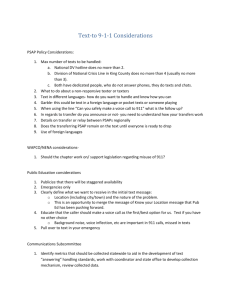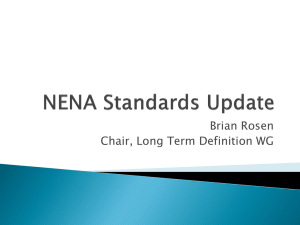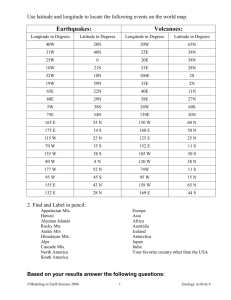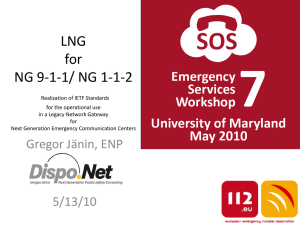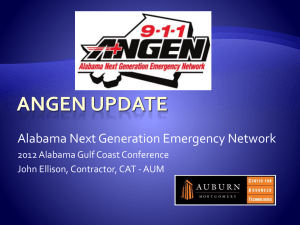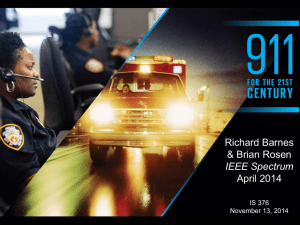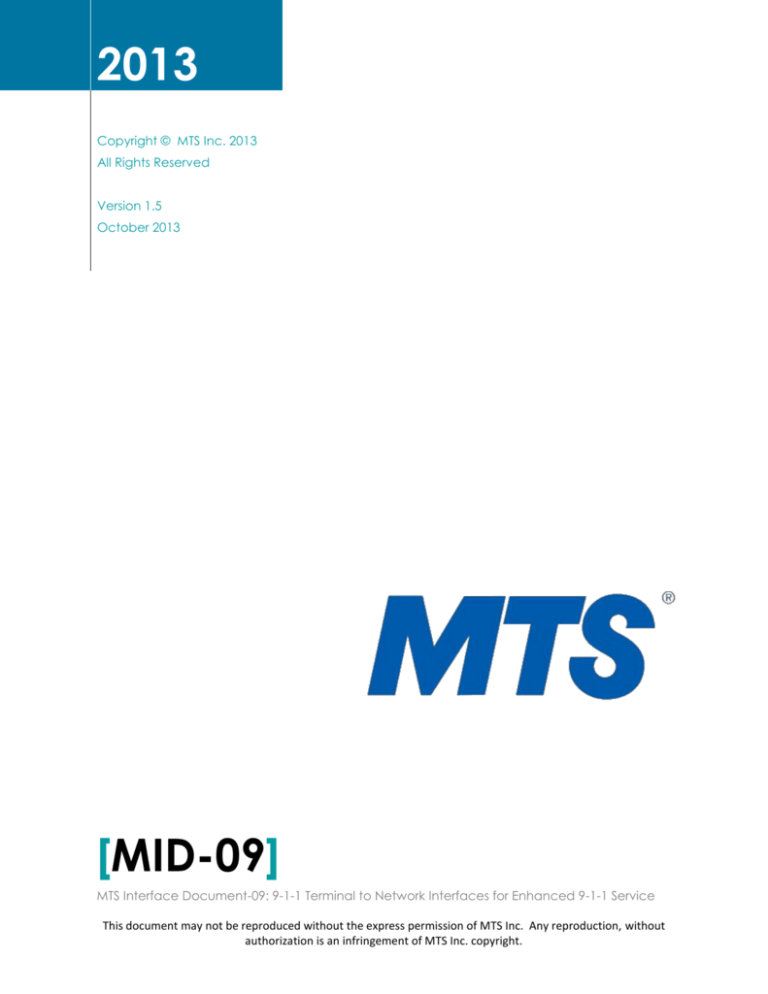
2013
Copyright © MTS Inc. 2013
All Rights Reserved
Version 1.5
October 2013
[MID-09]
MTS Interface Document-09: 9-1-1 Terminal to Network Interfaces for Enhanced 9-1-1 Service
This document may not be reproduced without the express permission of MTS Inc. Any reproduction, without
authorization is an infringement of MTS Inc. copyright.
1
1. CONTENTS
1.
Contents ................................................................................................................................................................1
2.
Executive Summary ...............................................................................................................................................2
3.
Document History ..................................................................................................................................................2
4.
Disclaimer and Limitation of Liability ....................................................................................................................3
5.
Service Description ................................................................................................................................................4
6.
Integrated Features Description ............................................................................................................................4
6.1.
Called Party Hold ..........................................................................................................................................4
6.2.
Calling Party Switch Hook Status ..................................................................................................................4
6.3.
Ring-back to 9-1-1 Caller ..............................................................................................................................4
6.4.
Fixed Call Conference and Transfer .............................................................................................................4
6.5.
Selective Call Conference and Transfer ........................................................................................................4
6.1.
Missed 9-1-1 Call ..........................................................................................................................................5
6.1.
Manual ALI ...................................................................................................................................................5
7.
Network Provided Features Description ...............................................................................................................5
7.1.
Selective Routing ..........................................................................................................................................5
7.2.
Automatic Number Identification (ANI) .......................................................................................................5
7.3.
Automatic Location Identification (ALI) .......................................................................................................5
7.4.
Outgoing Trunk Transfer ..............................................................................................................................5
7.5.
Wireless Location .........................................................................................................................................5
7.6.
PSAP Initiated In Call Location Update (ICLU) ..............................................................................................6
8.
Service Provider to PSAP Interface High Level .......................................................................................................7
8.1.
9.
High Level Diagram ......................................................................................................................................7
Overview of Call In Progress ..................................................................................................................................8
10.
Interface Descriptions ......................................................................................................................................8
10.1.
MTS Managed SR to PSAP CPE Interface .....................................................................................................8
10.2.
Non-Managed SR to PSAP CPE Interface ......................................................................................................8
10.3.
CAD Interface ...............................................................................................................................................9
10.4.
ALI Interface .................................................................................................................................................9
10.5.
Text 9-1-1 Interface ......................................................................................................................................9
11.
Acronyms ........................................................................................................................................................10
12.
References ......................................................................................................................................................11
MID-09 PAGE 1
COPYRIGHT © MTS INC. 2013
2
2. EXECUTIVE SUMMARY
This document describes the interfaces between the 9-1-1 Public Safety Answering Point (PSAP), other emergency
response agencies (ERAs), and the MTS 9-1-1 network. These interfaces allow PSAP attendants to answer 9-1-1 calls
which pass through MTS’s 9-1-1 network, and to transfer those calls to the appropriate emergency response agency.
PSAP and ERA attendants also have access to calling number, location information of the 9-1-1 caller, as well as other
advanced call control features provided by the network.
3. DOCUMENT HISTORY
Version
Date
Description
1.4
October 2013
Initial public release
1.5
November 2013
Updated contact info
MID-09 PAGE 2
COPYRIGHT © MTS INC. 2013
3
4. DISCLAIMER AND LIMITATION OF LI ABILITY
The information contained herein is proprietary to MTS Inc. (“MTS”) and, as such, may not be used, reproduced or
disclosed to others except as specifically permitted in writing by MTS. The recipient of this document, by its
retention and use, agrees to protect the same and the information contained therein from loss, theft and
compromise. MTS reserves the right to make changes, as required, to the information contained in this document.
MTS expressly advises readers that the technical requirements contained herein may change.
MTS SHALL NOT BE LIABLE FOR ANY DAMAGES OR INJURIES INCURRED BY ANYONE, INCLUDING BUT NOT LIMITED
TO CORPORATIONS, ARISING DIRECTLY OR INDIRECTLY FROM ANY INCOMPATIBILITY BETWEEN THE NETWORK(S)
OF MTS AND ANY TERMINAL DEVICE OR OTHER NETWORK, OR FROM ANY CAUSE WHATSOEVER.
If further information is required, please contact:
MTS E9-1-1 Senior Product Manager
MTS Inc.
Tel: (204) 941-8189
PO Box 6666, 14th Floor
333 Main Street (MP14K)
Winnipeg, MB R3C 3V6
MID-09 PAGE 3
COPYRIGHT © MTS INC. 2013
4
5. SERVICE DESCRIPTION
Provincial 9-1-1 Service provides customers with access to a Public Safety Answering Point (PSAP) via the Public
Switched Telephone Network (PSTN), as well as the mechanism for communications between the PSAP and
secondary agencies such as police, fire, and ambulance dispatch centres. The primary characteristics of the service
are:
Universally recognized (in 9-1-1 serving areas) 3-digit dialing (9-1-1) for connection to emergency response
agencies that service the location of the caller
High grade of service (P.001, or <= 0.1% probability of call blocking)
Special features to support the proficiency and effectiveness of 9-1-1 answering attendants
In a typical operation, the 9-1-1 call is delivered to the PSAP where an attendant determines the nature of the
emergency, then forwards the call to the appropriate fire, police or ambulance dispatch center. The PSAP attendant
is supported by the aforementioned special features which facilitate a targeted, timely, and accurate response.
Provincial 9-1-1 service is associated with all primary exchange services. Local governments are responsible for the
answering bureaus and dispatch centres.
6. INTEGRATED FEATURES DESCRIPTION
Provincial 9-1-1 Service is based on Cassidian’s ECS-10001 Selective Routing and Integrated PSAP attendant platform
(Sentinel), and supports the following network based features. These integrated features are primarily offered as a
part of the ECS-1000 to PSAP Sentinel Interface described in Section 10.1. These features are only available to PSAPs
who use the Sentinel platform.
6.1. CALLED PARTY HOLD
Called Party Hold will ensure that 9-1-1 callers who hang up prior to the call being answered have their line held
open for a period of time in order to allow the PSAP operator to answer the call. During this time the 9-1-1 caller
cannot dial out to other numbers. This feature is not available on wireless or IP based phone systems.
6.2. CALLING PARTY SWITCH HOOK STATUS
Calling Party Switch Hook Status will automatically inform the PSAP attendant when the calling party has gone ONHOOK via a visible indicator on the PSAP attendant’s Sentinel position.
6.3. RING-B ACK TO 9-1-1 CALLER
Ring-Back is a feature that allows the PSAP attendant to make the 9-1-1 caller’s set ring if it has been put ON-HOOK.
6.4. FIXED CALL CONFERENCE AND TRANSFER
Fixed Call Conference and Transfer allows the PSAP attendant to add on (conference) a secondary agency by
activating a transfer code associated with that specific agency.
6.5. SELECTIVE CALL CONFE RENCE AND TRANSFER
1
ECS-1000 ANI/ALI Controller is a registered trademark of Cassidian Communications Inc.
MID-09 PAGE 4
COPYRIGHT © MTS INC. 2013
5
Selective Call Conference and Transfer allows a PSAP attendant to add on a secondary agency (3-way conference)
by activating the appropriate transfer code for the desired agency. The network will make use of the ESZ information
to contact the appropriate agency for the calling party.
6.6. MISSED 9-1-1 CALL
Missed 9-1-1 Call allows the PSAP attendant to receive ANI/ALI information informing them about 9-1-1 calls that
have been missed. These calls will be placed in the abandoned queue prior to being answered.
6.7. MANUAL ALI
Manual ALI allows the PSAP attendant to manually request an ALI record for a fixed POTS service (currently wireline
and fixed VoIP).
7. NETWORK PROVIDED FEATURES DESCRIPTION
The Network Provided Features can be provided via the MTS Managed SR to PSAP CPE, as well as a direct interface
with specialized PSAP owned and operated customer premises equipment (CPE).
7.1. SELECTIVE ROUTING
A centralized database matches the 9-1-1 caller’s address to an Emergency Service Zone (ESZ). The ESZ describes
the municipal fire, police, and ambulance serving areas. This feature determines the caller’s location from the
database using their ANI. It then automatically routes emergency calls to the PSAP responsible for the ESZ based on
that location.
7.2. AUTOM ATIC NUMBER IDE NTIFICATION (ANI)
The Selective Router (SR) will transmit an ANI record that identifies the telephone number (TN) of the 9-1-1 caller.
This record is sent to the 9-1-1 ALI which processes the record to provide Automatic Location Identification (ALI).
7.3. AUTOM ATIC LOCATION I DENTIFICATION (ALI)
The MTS hosted ALI platform can transmit the caller’s name, address, and TN. The ALI information is transmitted
from the hosted ALI to the Sentinel position or PSAP hosted switch in ASCII format.
7.4. OUTGOING TRUNK TRANSFER
The outgoing trunk transfer feature allows outgoing trunks from the ECS-1000 to a PSAP controller switch to carry
speed calling codes back from the answering call taker via the PSAP controller switch (if supported by the PSAP
controller switch). The ECS-1000 will respond to a flash plus a speed calling code sent by the PSAP controller. This
feature must be specifically requested and set up on the outgoing trunk to operate properly. Speed calling codes
will be pre-configured on the ECS-1000 switch per the PSAPs requirements.
7.5. WIRELESS LOCATION
Wireless Location provides the PSAP attendant with the location of callers who are using a mobile phone. Phase I
location information is based on the cellular tower location (physical address), which will be followed a few seconds
later by Phase II information which provides the geolocation of the caller in the form of latitude / longitude, and
radius of uncertainty (Phase II stage 1).
MID-09 PAGE 5
COPYRIGHT © MTS INC. 2013
6
7.6. PSAP INITIATED IN CALL LOCATION UPDATE (ICLU)
In Call Location Update (ICLU) allows the PSAP attendant to manually request a location update from the network
for a wireless 9-1-1 call that is currently in progress (Phase II stage 2).
MID-09 PAGE 6
COPYRIGHT © MTS INC. 2013
7
8. SERVICE PROVIDER TO PSAP INTERFACE HIGH LEVEL
The diagram below describes 3 possible methods of deployment for interfacing with the MTS Provincial 9-1-1 service.
Each link below describes the specific physical product (eg. CAMA T1), link protocol (eg. RS-232), and
communications protocol (e.g. GTE CAD) required to communicate with the elements on the diagram.
PSAP Example Site 1 is an example of a single PSAP hosted switch and CAD connecting to the MTS Provincial
9-1-1 Service
PSAP Example Site 2 is an example of a geo-diverse PSAP hosted switch and CAD connecting to the MTS
Provincial 9-1-1 Service; Example Site 2 includes Example Site 1 for the diverse location
PSAP Example Site 3 is an example of a PSAP being hosted off of the MTS Sentinel platform. Specific link
and communications protocols are proprietary; the platform is an end-to-end MTS provided platform
8.1. HIGH LEVEL DIAGRAM
PSAP Example Site 1
PSAP Example Site 2
PSAP
Position
CAD Server
DS0 / RS232
GTE CAD
PSAP Example Site 3
PSAP
Position
CAD Server
PRI
PSAP Switch
PSTN
Cassidian
Sentinel
Position
PSAP Switch
PRI
Physical Demarcation
Phys ical Demarcation
DS0 / RS232
GTE CAD
MTS e911 Datacenter Main
MTS e911 Datacenter Vernon
BIP or RS232
cml20
EMF / CAMA T1
FGD_PANI_NENA
EMF / CAMA T1
FGD_PANI_NENA
BIP or RS232
cml20
ALI
RS232
cml20
SEALI
RS232
DS0 / RS232
GTE CAD
Sentinel Voice
911 Call Transfer
*flash code
ALI Query
cml20
CAD Server
Sentinel Data
BIP
IP, PUSH ALI
20 Digits
EMF / CAMA T1
FGD_PANI_NENA
ECS 1000
MF
Multiple COs
SS7
ECS 1000
RS232
SEALI
RS232
cml20
ALI
MF
SS7
DMS(s)
MSC
Note: Physical demarcation is in PSAP telephone
room
MID-09 PAGE 7
Terminal to Network Interface
Version 5
October 2, 2013
For Public Release
COPYRIGHT © MTS INC. 2013
8
9. OVERVIEW OF CALL IN PROGRESS
After dialing 9-1-1 the call and the caller’s ANI (along with the pseudo-ANI (pANI) for wireless-originated calls) is
transmitted from the originating switching center via a dedicated 9-1-1 trunk to the ECS-1000 switch. The ECS-1000
looks up the ESZ using the ANI/pANI, and routes the call to the appropriate PSAP.
Generally, once a 9-1-1 call is answered in the PSAP, the ANI information and identification of the agency and line
which the call was routed to is forwarded to the ALI for processing. If the PSAP is using the MTS Sentinel solution,
the ALI information is then sent to the attendant’s Sentinel position. If the PSAP is using another PBX system or
other specialized 9-1-1 terminal equipment, additional information may be required to support the ALI feature and
route it to the correct terminal. This information could include the incoming voice line number or position ID of the
agent.
10. INTERFACE DESCRIPTIONS
10.1.
ECS-1000 TO PSAP SENTINE L INTERFACE
As in PSAP Example Site 3, in Section 8, the recommended interface for a PSAP to receive 9-1-1 calls, ANI/ALI
information on the MTS Provincial 9-1-1 Service is to use the fully integrated, Sentinel solution. In this model the
ECS-1000 not only acts as a Selective Router, but also as a Controller. Specialized hardware used by the PSAP is
tightly integrated with the Selective Router, and communicates with it using proprietary Cassidian Communications
Inc. protocols. This tight integration allows for additional functionality; the PSAP attendant is provided with a
Microsoft Windows-based GUI to manage all the aforementioned service features. Rather than relying on Electronic
Business Sets (EBS) sets and customized PSTN features, the PSAP attendant can use a system that has full integration
with the host 9-1-1 switch (ECS-1000).
10.2.
ECS-1000 TO PSAP CPE INTERFACE
As an alternative to the ECS-1000 to PSAP Sentinel Interface, the ECS-1000 can also interface with PSAP customer
premises equipment (CPE). This section will provide guidelines for such an implementation, and the PSAP customer
should expect that there would be development (professional services) and rigorous integration testing to certify
the platform for accepting 9-1-1 calls.
10.2.1. PHYSICAL
The ECS-1000 accepts 4 wire physical copper circuit.
10.2.2. DATA LINK
The Data Link layer currently supports Enhanced MF for FGD and Analog CAMA Trunks
10.2.3. COMMUNICATIONS PROTO COL
The ECS-1000 currently supports NENA Standard (Feature Group D) for the Implementation of Enhanced MF
Signaling E9-1-1 Tandem to PSAP (FGD_PANI_NENA). See Reference (National Emergency Numbers Association,
2007). The purpose of Enhanced MF is to facilitate the delivery of one or two ten-digit ANI transmissions to the
PSAP.
MID-09 PAGE 8
COPYRIGHT © MTS INC. 2013
9
10.3.
CAD INTERFACE
10.3.1. PHYSCIAL
The physical CAD interface utilizes a 2 wire, dedicated DS-0 data circuit which requires no dialing.
10.3.2. DATA LINK
The data link conforms to RS-232, and is transmitted via modems operating at 8 bits, No Parity, 1 Stop bit (8N1).
10.3.3. COMMUNICATIONS PROTO COL
The CAD interface can make use of any of 4 different protocols, as outlined in Reference (Cassidian Communications
Inc. (formerly CML Technologies), 2013). This document is available from MTS under NDA. Please see contact
information in Section 4 to request the document. The four protocols are:
GTE CAD
CAD with ESN
CAD with Complete Information (CML)
CAD AT&T
10.4.
ALI INTERFACE
10.4.1. PHYSCIAL
The ALI physical interface has 3 options, depending on the desired Data Link layer. If using RS-232 the standard 2
wire, dedicated DS-0 data circuit is required. However, if IP is desired, either Ethernet (CAT5), DS-1/T1, Fiber, or
other IP compatible physical link can be used, depending on a number of factors such as location.
10.4.2. DATA LINK
Either RS-232, transmitted via modems operating at 8N1, or IP via the MTS Business IP (BIP) MPLS service.
10.4.3. COMMUNICATIONS PROTO COL
The ALI interface currently supports one protocol, cml20, as outlined in Reference (PlantCML, 2009).
10.5.
TEXT WITH 9-1-1 INTERFACE
The Text with 9-1-1 interface that MTS provides is based on the Agent511 TextBlue SMS T9-1-1 (TEXTBLUE)
application. TEXTBLUE is designed to integrate with 3rd party applications, and also supports bidirectional messaging.
Additionally, TEXTBLUE provides a web interface which can be used directly by a PSAP attendant.
10.5.1. PHYSICAL
Either Ethernet (CAT5), DS-1/T1, Fiber, or other IP compatible physical link can be used, depending on a number of
factors such as location.
MID-09 PAGE 9
COPYRIGHT © MTS INC. 2013
10
10.5.2. DATA LINK
The Text with 9-1-1 Interface is only available via IP, over the private MTS BIP MPLS Service.
10.5.3. TEXT WITH 9-1-1 COMMUNICATIONS PROTO COL WEB INTERFACE OPTION
The interaction with the TEXTBLUE web interface is described in Reference Document (AGENT511, 2013)
10.5.4. TEXT WITH 9-1-1 COMMUNICATIONS
INTEGRATION OPTION
PROTO COL
API
FOR
CAD
The interaction with the TEXTBLUE API for CAD integration is described in Reference Document (AGENT511, 2013)
11. ACRONYMS
Acronym
ALI
ANI
ASCII
BIP
CAD
CAMA
CAT5
CPE
DS-0
EBS
ERA
ESZ
FGD
ICLU
IP
MPLS
MF
NENA
pANI
POTS
PSAP
PSTN
RS-232
SMS
SR
T1
TN
VoIP
Definition
Automatic Location Identification
Automatic Number Identification
American Standard Code for Information Interchange
Business Internet Protocol (MTS MPLS Product Name)
Computer Aided Dispatch
Centralized Automatic Message Accounting (refers to Enhanced MF trunks for 911)
Category 5 Ethernet cable
Customer Premise Equipment
Digital Signal 0 (refers to a single 2 wire phone circuit)
Electronic Business Sets
Emergency Response Agency
Emergency Services Zone
Feature Group D (a tariffed set of features governing long distance selection)
In Call Location Update
Internet Protocol
Multi-Protocol Label Switching
Multi-Frequency
National Emergency Numbers Association
Pseudo-Automatic Number Identification (for use with cellular calls)
Plain Old Telephone System
Public Safety Answering Point
Public Switched Telephone Network
Radio Sector 232 (serial communications protocol for 3 or 5 wire connections)
Short Message Service (Text messaging for cellular phones)
Selective Router
Or DS1, refers to a 4 wire trunk which can carry up to 24 voice channels
Telephone Number
Voice over IP
MID-09 PAGE 10
COPYRIGHT © MTS INC. 2013
11
12. REFERENCES
Cassidian Communications Inc. (formerly CML Technologies), 2013. Communication Protocol with CAD Interfaces,
s.l.: Martin Boucher *
Cassidian Communications Inc. (formerly PlantCML), 2009. 20 digits ALI protocol, s.l.: Denis Larviere*
*MTS will make this available to third parties who sign an applicable Non-Disclosure Agreement. For further
information please contact the person listed in Section 4 of this document.
AGENT511, 2013. TEXTBLUE multimedia chat API, Northbrook, Illinois: Good Egg Media LLC**
AGENT511, 2013. TEXTBLUE SMS T9-1-1 User's Guide, Northbrook, Illinois: Good Egg Media LLC**
**MTS will make available to readers upon request. To make the request please contact MTS at the address
in Seciton 4 of this document.
National Emergency Numbers Association, 2007. NENA Standard for the Implementation of Enhanced MF
Signaling, E9-1-1 Tandem to PSAP. [Online]
Available at: http://www.nena.org/resource/collection/1F053CE7-3DCD-4DD4-9939-58F86BA03EF7/NENA_03002-v2_Implementation_Enhanced_MF_Signaling_E9-1-1_Tandem_PSAP.pdf
MID-09 PAGE 11
COPYRIGHT © MTS INC. 2013

